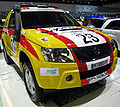2007 Suzuki Grand Vitara Owner's Manual - Page 133
2007 Suzuki Grand Vitara Manual
Page 133 highlights
VEHICLE LOADING AND TOWING Tongue Weight Gross Vehicle Weight Gross Axle Weight 60A380 60A379 60A382 Tongue Weight is the downward force exerted on the hitch by the trailer coupler, with the trailer fully loaded and the coupler at its normal towing height. Cargo should be distributed so that tongue weight is approximately 10% of gross trailer weight. NOTE: You can usually get tongue weight to be about 10% of gross trailer weight by placing about 60% of the total cargo weight in the front half of the trailer. You should measure gross trailer weight and tongue weight before towing, however, to make sure that your load is properly distributed. Gross Vehicle Weight is the weight of the fully loaded vehicle (including all the occupants, accessories and cargo plus the trailer tongue weight). The gross vehicle weight must never exceed the Gross Vehicle Weight Rating (GVWR) listed on the Safety Certification Label. Gross Axle Weight (Front and Rear) is the weight supported by an individual axle with the vehicle fully loaded and the trailer connected. Gross axle weight for the front and rear axles must never exceed the Gross Axle Weight Rating (GAWR) listed on the Safety Certification Label. WARNING Improper distribution of cargo in your trailer may result in poor vehicle handling and swaying of the trailer. Always make sure that trailer tongue weight is about 10% of gross trailer weight. Failure to observe this requirement may result in an accident. 8-4
















